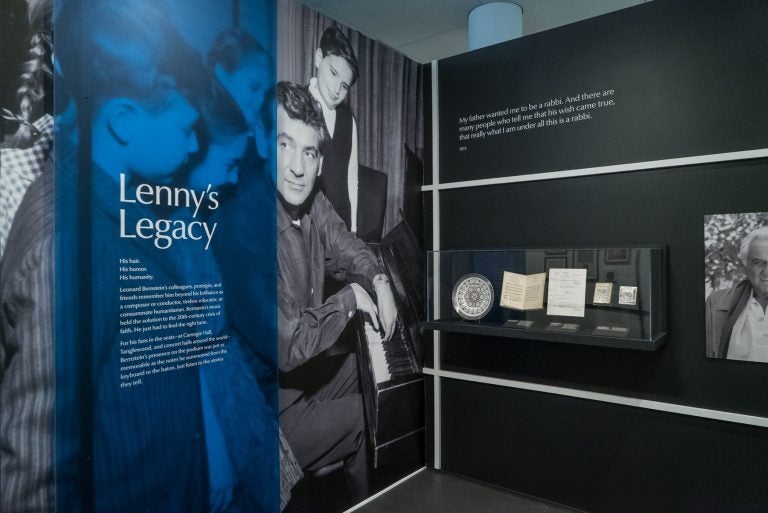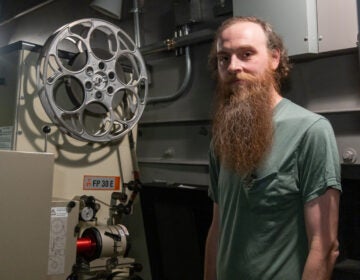Leonard Bernstein’s crisis of faith begot music that buoyed U.S. through horrors
Philadelphia National Museum of American Jewish History opens exhibition about Leonard Bernstein and his lifelong crisis of faith.

National Museum of American Jewish History celebrates Leonard Bernstein's 100th birthday with an exhibit, "Leonard Bernstein: the Power of Music." (National Museum of American Jewish History)
This year marks the centenary of Leonard Bernstein, the American composer born on Aug. 25,1918. At least 2,700 events around the world will honor one of the most popular composers of the 20th century.
This weekend in Philadelphia, the National Museum of American Jewish History is launching an exhibition about the struggles and conflicts in his life. It runs until September.
To the casual listener who remembers Leonard Bernstein as the guy who wrote the music for “West Side Story” — “Officer Krupke” and “America,” for example — he may seem buoyant and jolly.
That’s how he appeared to his daughter Jamie while growing up.
“There was all this conviviality. That never went away,” she said during a visit to the museum. “But I always mark it at Nov. 22, 1963. That was the first time I saw my parents cry. That was when we began to have a sense that adults were troubled, and carried the burdens of a difficult world.”
She’s referring to the day President John F. Kennedy was assassinated.
“Leonard Bernstein: The Power of Music” traces the composer’s long career as an artist grappling with the terrible events of the 20th century — war, racism, and nuclear annihilation — through his music.
Much of that music also became phenomenally popular. The music’s power was not just its ambition and genius, but that people wanted to hear it.
Bernstein studied at the Curtis Institute in Philadelphia, describing it as “a city of dust and grit and horror.” His first year was difficult. As a Harvard graduate who wore his already stellar reputation on his sleeve, he was avoided by fellow students.
And he avoided them, feeling the school was too focused on training virtuosos and not enough on using music to engage with the world. Eventually, he would find peers who shared his ideas about being a composer in society.
The museum exhibition consists mostly of documents as well as black and white photos. It has a muted palette of white, black and dark blue. The lighting is low. Except for a video booth of clips showing Bernstein’s music appearing in popular culture (“The Simpsons,” “Saturday Night Live,” the Jack Nicholson/Adam Sandler comedy “Anger Management”), the tone of the room is restrained and respectful.
“He was a good-looking guy. The camera loved him,”said curator Ivy Weingram. “There is no shortage of good photography of Leonard Bernstein.”
“We wanted to convey his personality, both his exuberance and …,” she paused. “During the Cold War, he said, ‘Sometimes I tremble for my country.’ ”
Wresting melody from spiritual struggles
The central theme of the exhibition comes from a fan letter Bernstein received from a teacher in Virginia, asking him to identify a unifying idea running through his long body of work. In the margins of the letter, scrawled in red pencil, he started to write a response: He was searching for a solution to the 20th century crisis of faith.
“He had this tussle going on for himself with his spiritual and biological creators,” said daughter Nina Bernstein-Simmons. “He had a difficult time with his father, and he thought so much about his spiritual creator as well. As he worked out personal issues in his music, they became a metaphor for what everyone was going through in the 20th century.”
Although he reflected a great deal on religion, his children say he was not particularly religious. The family did not keep the Sabbath or observe the high Jewish holidays.
“He may not have been a practicing Jew, but he really knew his stuff,” said son Alexander Bernstein. “On Yom Kippur, he would take me what he called ‘shul hopping,’ go from temple to temple in Manhattan and time it so he could hear the cantors that he liked. He knew all the rabbis. He could sing all the prayers. Could read and speak Hebrew.”
In his first symphony, “Jeremiah” (1942), Bernstein took on a biblical story with a challenge to God, pleading for a reason to love him in the face of worldly devastation:
Wherefore dost thou forget us forever,
And forsake us so long time?
Three decades later, in “Mass” (1971), Bernstein still didn’t have an answer, but he had softened somewhat. It ends with “Secret Song,” learning to come to terms with his creator privately when he could not communally.
“He tussled with questions about religion through music,” said his daughter Nina. “His process of composing was his way of working out spiritual issues in himself.”
WHYY is your source for fact-based, in-depth journalism and information. As a nonprofit organization, we rely on financial support from readers like you. Please give today.





